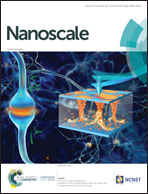Two-dimensional C60 nano-meshes via crystal transformation†
Abstract
Developing a rational and general approach towards complex two-dimensional (2D) nanostructures represents potential promising applications in a wide variety of fields, such as electronics, catalysis, and energy conversion. However, the synthesis of 2D nanoscale superstructures remains a great challenge because of the great difficulty in arranging the growth units in a rational manner. Here, we develop a simple yet effective solution-phase strategy to achieve hexagonal mesh networks made of aligned nanorods which are obtained via crystal transformation of 2D C60 microplates. The transformation is triggered by the removal and inclusion of solvent molecules and hence, driven by a small free energy difference. The change in the local solvent environment leads to the formation of pores in the C60 plates and the subsequent growth of nanorods. The epitaxial growth of ordered nanorod arrays is due to the matching lattice between the (111) facet of the fcc plate and the (10![[1 with combining macron]](https://www.rsc.org/images/entities/char_0031_0304.gif) 0) facet of the hcp rod. This route of co-solvent induced crystal transformation provides a unique mechanistic perspective and a new direction for designing complex crystals. Furthermore, more complicated 2D C60 mesh networks, such as multi-layer hexagonal meshes, have also been rationally achieved via such a facile crystal transformation strategy.
0) facet of the hcp rod. This route of co-solvent induced crystal transformation provides a unique mechanistic perspective and a new direction for designing complex crystals. Furthermore, more complicated 2D C60 mesh networks, such as multi-layer hexagonal meshes, have also been rationally achieved via such a facile crystal transformation strategy.



 Please wait while we load your content...
Please wait while we load your content...